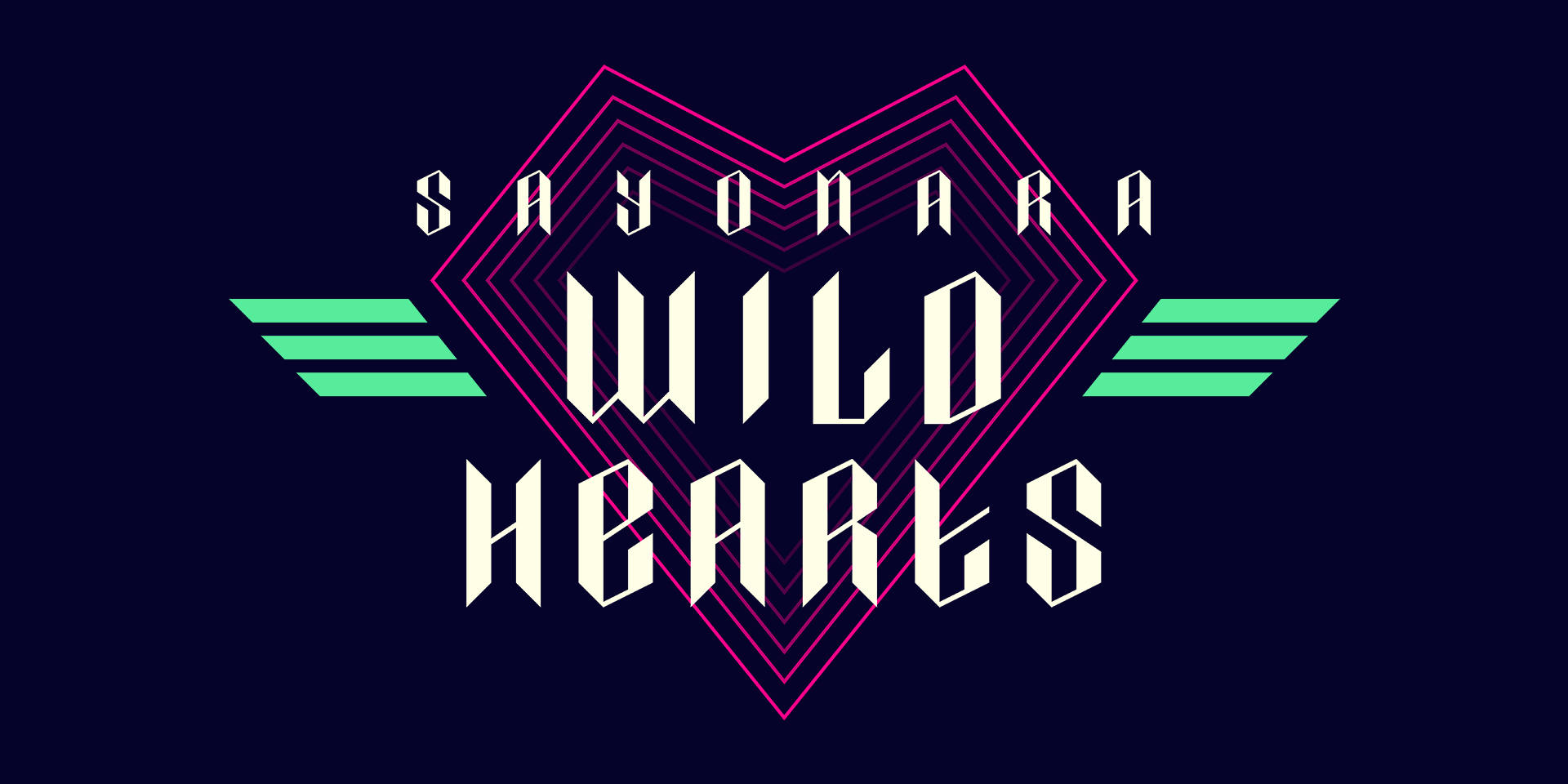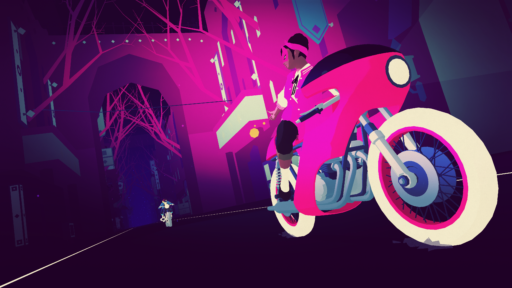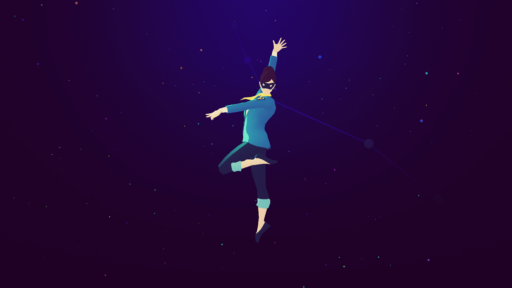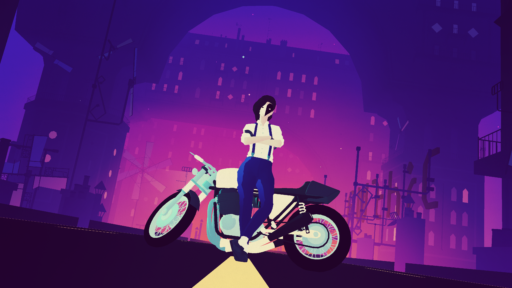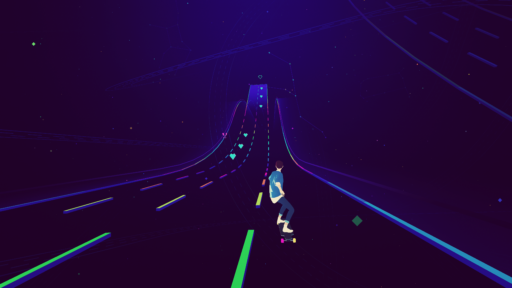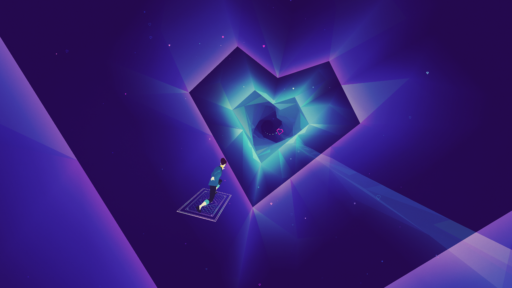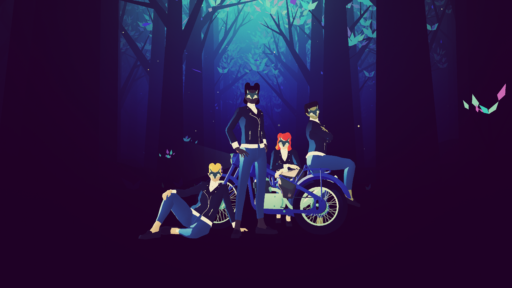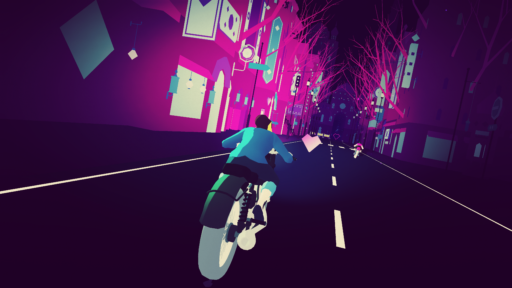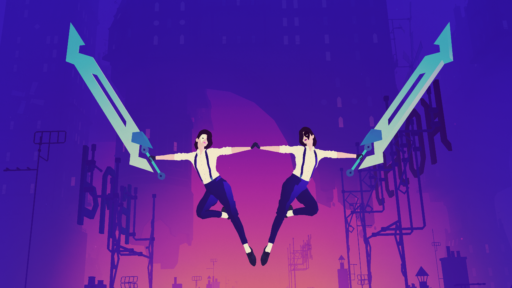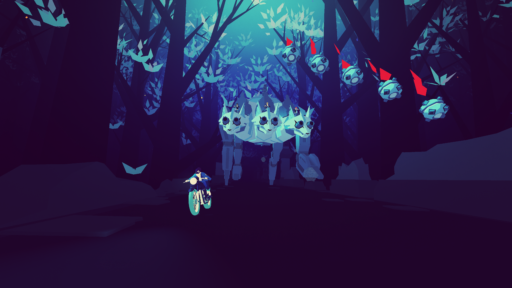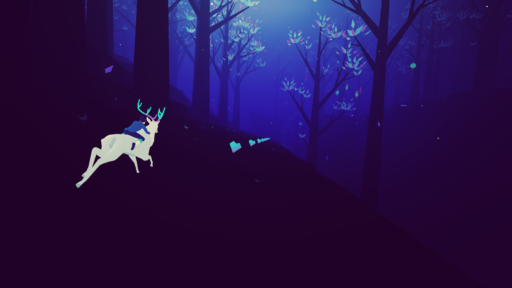
Sayonara Wild Hearts

Title:
Sayonara Wild Hearts

Genre:
Pop Arcade

First released:
Sep 19, 2019
A POP ALBUM VIDEO GAME
Sayonara Wild Hearts is a dreamy arcade game about riding motorcycles, skateboarding, dance battling, shooting lasers, wielding swords, and breaking hearts at 200 mph.
As the heart of a young woman breaks, the balance of the universe is disturbed. A diamond butterfly appears in her dreams and leads her through a highway in the sky, where she finds her other self: the masked biker called The Fool.
Journey through a custom-written pop soundtrack, chase scores, and set out to find the harmony of the universe, hidden away in the hearts of Little Death and her star-crossed allies: Dancing Devils, Howling Moons, Stereo Lovers and Hermit 64.
Let’s Pop!

Gameplay & Development
Sayonara Wild Hearts is, at heart, a simple arcade game, controlled with a directional input and a button. Each level is a song on a pop album soundtrack, and while not being a rhythm game, it follows the ebbs and flows of each track. Throughout the game, you control a character called “The Fool”, often on her bike at breakneck speeds, sometimes on a skateboard, in a car, or even flying on a sword, as she makes her way through levels, to find and defeat other bikers in a mysterious universe inspired by tarot cards. The action constantly shifts, and the camera follows the action automatically, and dynamically. Sometimes, button prompts appear, and players must time their button presses to perform actions like jumps, sword strikes and punches. Sayonara Wild Hearts is also a soup made of pop-culture. It’s the teddygirls sub-culture, cafe racers, OutRun













It all started with a drawing of a woman wearing a mask and some thoughts that had been bubbling for a while. After making three slow and thinky games, it was time to make something action-filled. Something that was more gut than brain. Something that’d be thrilling, and fill you with euphoria, like a good pop song. We wanted to make a video game that was unashamed of being a video game.
We also wanted to explore how to design a 3D action game that felt as spectacular and cinematic as a modern blockbuster game, but with the simplicity and nimbleness of the games we grew up with: the arcade games which never needed more than one button and four directions to feel amazing in your hands. Sayonara Wild Hearts was, then, born as a protest against video games becoming uninviting. Why are we actively pushing people out of this medium? Why can’t there be great looking 3D games, not operated by 12 buttons and 2 sticks simultaneously? Why can’t there be awesome action games without convoluted systems? And, most importantly: Why do we keep on putting the same type of characters in them? The answer to these questions became the seed for Sayonara Wild Hearts, an action game that would feel inviting, without compromising what makes an action game good: the thrill. A game that could be enjoyed equally by people who play videogames all the time and people who have no interest, or are even scared to play video games. We wanted that game to constantly throw new surprises at you, without having to explain new control schemes, mechanics or systems.
Simon had been drawing characters inspired by the Teddygirl culture for a while. We got in touch with our former colleague Carl Karjalainen, and showed him some early concepts to see if he was interested in modelling, rigging and animating a character or two for a prototype. He agreed, and ended up staying for the entire project, modelling and rigging all characters, as well as creating every single character animation in the game.
We started to make a prototype featuring masked biker gangs based on tarot cards. The vibe was dark, mysterious, and inspired by Lord Huron’s

For about a year, we had gotten e-mails from Annapurna Interactive
As a project, Sayonara Wild Hearts was filled with strange events, star aligning and surprises (both welcome and unwelcome). One of the unanticipated things was having Queen Latifah as the narrator, which happened very late in the project—in fact, it was the last addition of the entire production.
The game was a big challenge for us, and took over four years to create. It was first revealed for Nintendo Switch, and became part of the Apple Arcade platform launch. It was initially released on Nintendo Switch, PlayStation 4 and Apple Arcade September 19th 2019. After the launch, we ported the game to PC/Windows and Xbox One. It released on Steam December 12th 2019, and on Xbox One February 25th 2020.

Images
The characters were established early, but the environment and settings took long to get right. As the music shifted from shifted from dark and mysterious, the visuals had to follow. We decided to make the game vibrant and highly saturated, in hues of purple and pink. Only the characters use traditional lighting, while the environments are not lit at all. Instead, they depend on a depth fog.
Our workflow for the environments was tedious, but got faster as we got further into the project. The different settings use different methods, combining tiles, special tiles, and completely custom built and placed geometry. In hindsight, making the level creation more systems-based would have saved us a lot of time, but would perhaps have compromised the vision of the game, which was to constantly throw surprises at the player.
Each level in Sayonara Wild Hearts is, simplified, actually an animation, with a road surface and lots of values attached to it. The master level animation defines every event, the camera, visual changes, where the characters are on the road at a specific time: every imaginable value can be animated in the levels.
Åsa Wallander had previously designed the Simogo logo and the DEVICE 6 logo. She joined the team to create all of the 2D art for the game, including promotion materials like a tarot card deck



Videos
Sayonara Wild Hearts was first shown at The Game Awards

Music
While playing an early prototype of Sayonara Wild Hearts, a playlist with energetic electronic pop music was on in the background, and somehow, what was happening on the screen married perfectly to what was happening from the speakers in the room. It couldn’t have taken more than one day, until we asked Jonathan to start writing pop songs about heartbreak, and Daniel to arrange them with a vibrant electric production. A year earlier, we had approached artist Linnea Olsson after a record store gig here in town, and told her that she should get in touch if she ever wanted to make music for a game. A year later, with an almost unbelievable amount of star alignment, an email popped up from her, just as we were looking for a singer for the first song of the game. And so, it seemed that we had suddenly put together a pop band.
During the project, we made a lot of tests, demos and ended up throwing away a lot of material. We collected all of these on a cassette and sold it through Annapurna Interactive’s online shop. It’s sold out, but someone uploaded the entire cassette to Youtube

Game Credits
Art, sound, music & design direction, Level art & design, Character design, Project management
Simon Flesser
Technical direction, Programming, Project management
Magnus “Gordon” Gardebäck
Programming
Magnus Jensen
Programming
Björn Persson
Animation, Character & vehicle modelling, Technical art
Carl Karjalainen
2D art, Menu design, Logo design
Åsa Wallander
Instrumental music, Pop music production & arrangement, Sound design, Additional design & art
Daniel Olsén
Pop music, Lyrics
Jonathan Eng
Vocals
Linnea Olsson
Voices
Kara Drapala
Narration
Queen Latifah
Made with the support of
Annapurna Interactive
Quality Assurance
HUWIZ QA/UX
Translation
EDS Wordland Ltd
BADA GAMES
Keywords Studios

Reviews, Press & Awards
Reviews
Metacritic
Metacritic
Metacritic
Metacritic
Metacritic
Opencritic
TouchArcade
NintendoLife
Eurogamer
Washingtong Post
Polygon
Press
Vice – ‘Sayonara Wild Hearts’ Is a Brilliant, Beautiful Celebration of Pop Music
Rock Paper Shotgun – Have You Played… Sayonara Wild Hearts?
NPR – The Sweet Escape Of ‘Sayonara Wild Hearts,’ Where Pop Music Is Recovery
GQ – Sayonara Wild Hearts is proof that simple games can be brilliant
Apple.com – Behind the Design: Sayonara Wild Hearts
The Verge – Sayonara Wild Hearts is an electrifying ride through a world made of pop culture
Mashable – Switch game ‘Sayonara Wild Hearts’ feels like a playable, edgier ‘Sailor Moon’
Awards
Apple Design Award 2020 (Winner)
Artistic Achievement at BAFTA Games Awards 2020 (Winner)
Animation at BAFTA Games Awards 2020 (Nominated)
Best Independent Game at Game Critics Awards (Nominated)
Best Visual Design at Golden Joystick Awards (Nominated)
Best Indie Game at Golden Joystick Awards (Nominated)
Best Soundtrack at Titanium Awards (Nominated)
Best Art Direction at The Game Awards (Nominated)
Best Score/Music at The Game Awards (Nominated)
Best Mobile Game at The Game Awards (Nominated)
A-Train Award for Best Mobile Game at New York Game Awards (Winner)
Tin Pan Alley Award for Best Music in a Game at New York Game Awards (Winner)
Off Broadway Award for Best Indie Game at New York Game Awards (Nominated)
Game of the Year at Pocket Gamer Awards (Nominated)
Best Audio/Visual Accomplishment at Pocket Gamer Awards (Nominated)
Best Music Supervision in a Video Game at Guild of Music Supervisors Awards (Nominated)
Portable Game of The Year at D.I.C.E. Awards (Winner)
Outstanding Achievement for an Independent Game at D.I.C.E. Awards (Nominated)
Outstanding Achievement in Audio Design at D.I.C.E. Awards (Nominated)
Contemporary Art Direction at NAVGTR Awards (Nominated)
Camera Direction in a Game Engine at NAVGTR Awards (Nominated)
Music or Performance-Based Game at NAVGTR Awards (Nominated)
Song Collection at NAVGTR Awards (Nominated)
Best International Mobile Game at Pégases Awards 2020 (Winner)
Best Visual Art at Game Developers Choice Awards (Nominated)
Best Mobile Game at Game Developers Choice Awards (Nominated)
Mobile Game of the Year at SXSW Gaming Awards (Nominated)
Excellence in Art at SXSW Gaming Awards (Nominated)
Excellence in Musical Score at SXSW Gaming Awards (Nominated)
Apple Arcade Game of the Year

Age Ratings


ESRB content descriptors:
Fantasy Violence

